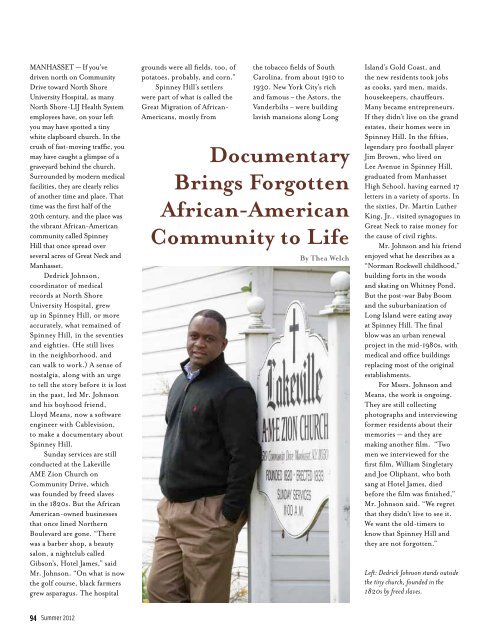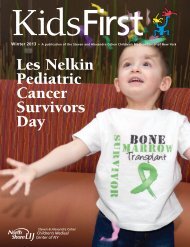Support for Soldiers and Veterans You Gotta Have Heart The Joy of ...
Support for Soldiers and Veterans You Gotta Have Heart The Joy of ...
Support for Soldiers and Veterans You Gotta Have Heart The Joy of ...
You also want an ePaper? Increase the reach of your titles
YUMPU automatically turns print PDFs into web optimized ePapers that Google loves.
MANHASSET — If you’ve<br />
driven north on Community<br />
Drive toward North Shore<br />
University Hospital, as many<br />
North Shore-LIJ Health System<br />
employees have, on your left<br />
you may have spotted a tiny<br />
white clapboard church. In the<br />
crush <strong>of</strong> fast-moving traffic, you<br />
may have caught a glimpse <strong>of</strong> a<br />
graveyard behind the church.<br />
Surrounded by modern medical<br />
facilities, they are clearly relics<br />
<strong>of</strong> another time <strong>and</strong> place. That<br />
time was the first half <strong>of</strong> the<br />
20th century, <strong>and</strong> the place was<br />
the vibrant African-American<br />
community called Spinney<br />
Hill that once spread over<br />
several acres <strong>of</strong> Great Neck <strong>and</strong><br />
Manhasset.<br />
Dedrick Johnson,<br />
coordinator <strong>of</strong> medical<br />
records at North Shore<br />
University Hospital, grew<br />
up in Spinney Hill, or more<br />
accurately, what remained <strong>of</strong><br />
Spinney Hill, in the seventies<br />
<strong>and</strong> eighties. (He still lives<br />
in the neighborhood, <strong>and</strong><br />
can walk to work.) A sense <strong>of</strong><br />
nostalgia, along with an urge<br />
to tell the story be<strong>for</strong>e it is lost<br />
in the past, led Mr. Johnson<br />
<strong>and</strong> his boyhood friend,<br />
Lloyd Means, now a s<strong>of</strong>tware<br />
engineer with Cablevision,<br />
to make a documentary about<br />
Spinney Hill.<br />
Sunday services are still<br />
conducted at the Lakeville<br />
AME Zion Church on<br />
Community Drive, which<br />
was founded by freed slaves<br />
in the 1820s. But the African<br />
American-owned businesses<br />
that once lined Northern<br />
Boulevard are gone. “<strong>The</strong>re<br />
was a barber shop, a beauty<br />
salon, a nightclub called<br />
Gibson’s, Hotel James,” said<br />
Mr. Johnson. “On what is now<br />
the golf course, black farmers<br />
grew asparagus. <strong>The</strong> hospital<br />
94 Summer 2012<br />
grounds were all fields, too, <strong>of</strong><br />
potatoes, probably, <strong>and</strong> corn.”<br />
Spinney Hill’s settlers<br />
were part <strong>of</strong> what is called the<br />
Great Migration <strong>of</strong> African-<br />
Americans, mostly from<br />
the tobacco fields <strong>of</strong> South<br />
Carolina, from about 1910 to<br />
1930. New York City’s rich<br />
<strong>and</strong> famous – the Astors, the<br />
V<strong>and</strong>erbilts – were building<br />
lavish mansions along Long<br />
Documentary<br />
Brings Forgotten<br />
African-American<br />
Community to Life<br />
By <strong>The</strong>a Welch<br />
Isl<strong>and</strong>’s Gold Coast, <strong>and</strong><br />
the new residents took jobs<br />
as cooks, yard men, maids,<br />
housekeepers, chauffeurs.<br />
Many became entrepreneurs.<br />
If they didn’t live on the gr<strong>and</strong><br />
estates, their homes were in<br />
Spinney Hill. In the fifties,<br />
legendary pro football player<br />
Jim Brown, who lived on<br />
Lee Avenue in Spinney Hill,<br />
graduated from Manhasset<br />
High School, having earned 17<br />
letters in a variety <strong>of</strong> sports. In<br />
the sixties, Dr. Martin Luther<br />
King, Jr., visited synagogues in<br />
Great Neck to raise money <strong>for</strong><br />
the cause <strong>of</strong> civil rights.<br />
Mr. Johnson <strong>and</strong> his friend<br />
enjoyed what he describes as a<br />
“Norman Rockwell childhood,”<br />
building <strong>for</strong>ts in the woods<br />
<strong>and</strong> skating on Whitney Pond.<br />
But the post-war Baby Boom<br />
<strong>and</strong> the suburbanization <strong>of</strong><br />
Long Isl<strong>and</strong> were eating away<br />
at Spinney Hill. <strong>The</strong> final<br />
blow was an urban renewal<br />
project in the mid-1980s, with<br />
medical <strong>and</strong> <strong>of</strong>fice buildings<br />
replacing most <strong>of</strong> the original<br />
establishments.<br />
For Mssrs. Johnson <strong>and</strong><br />
Means, the work is ongoing.<br />
<strong>The</strong>y are still collecting<br />
photographs <strong>and</strong> interviewing<br />
<strong>for</strong>mer residents about their<br />
memories — <strong>and</strong> they are<br />
making another film. “Two<br />
men we interviewed <strong>for</strong> the<br />
first film, William Singletary<br />
<strong>and</strong> Joe Oliphant, who both<br />
sang at Hotel James, died<br />
be<strong>for</strong>e the film was finished,”<br />
Mr. Johnson said. “We regret<br />
that they didn’t live to see it.<br />
We want the old-timers to<br />
know that Spinney Hill <strong>and</strong><br />
they are not <strong>for</strong>gotten.”<br />
Left: Dedrick Johnson st<strong>and</strong>s outside<br />
the tiny church, founded in the<br />
1820s by freed slaves.




